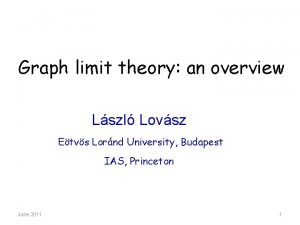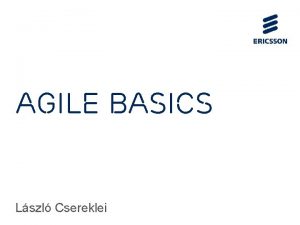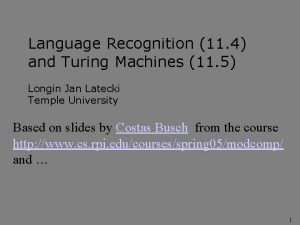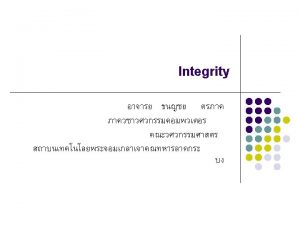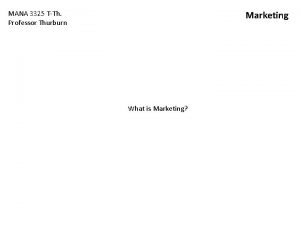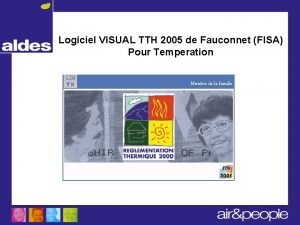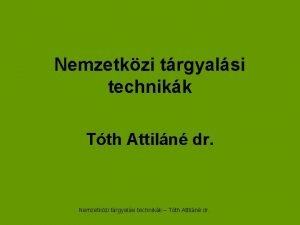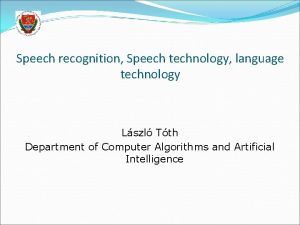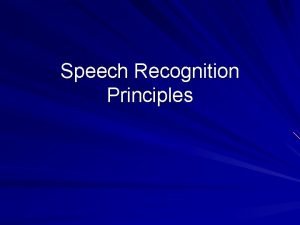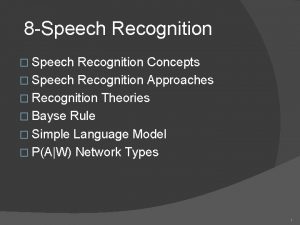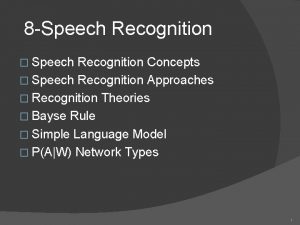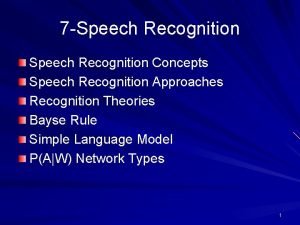Speech Recognition Approaches and Recognizer Architecture Tth Lszl







- Slides: 7

Speech Recognition Approaches and Recognizer Architecture Tóth László Számítógépes Algoritmusok és Mesterséges Intelligencia Tanszék

Introduction In this lecture I present what kind of approaches have been tried for speech recognition during the decades At the and of the lecture we arrive to the recent, machine learning-based systems. I will also quickly present the achitecture and main components of these systems

Knowledge-based systems In the 60 -80’s, the most popular approach in AI was the so-called knowledge-based systems. These was the main technology behind the socalled expert systems, And of course, the technology was also tried for speech recognition One main component of these systems is the knowledge base, this stores the knowledge related to the task, e. g. in the form of IF-THEN rules In the case of speech recognition, these were acoustic-phonetic rules, something like “if the actual phone is a plosive, the next phone is an [a], and the second formant goes downwards, then the actual phone is a [d]” Their other main component is a decision mechanism, for example some sort of rule-based or logic-based inference engine The most complex and most successful such speech recognizer was built in the 70’s in the USA (financed by the military). This could recognize grammatically very restricted sentences built from approximately 1000 words.

Template matching-based approaches By the end of the 70’s the development of knowledge-based systems became slow, because extending/correcting a large rule set is very difficult However, the computing and storage capacity of computers grew very fast This gave the idea to replace the expert knowledge by simple computation: a comparison to stored templates (template matching) Fred Jelinek: „Every time I fire a linguist, the recognition accuracy goes up” We store a reference template for each unit (word, expression) that we want to recognize In recognition phase, the actual input is compared to each stored template, and the most similar is returned as the results of the recognition No need for linguistic knowledge, but the proper choice of the distance function used for the comparison is of course vital The most well-known such algorithm is dynamic time warping, DTW

Machine learning-based methods, the Hidden Markov Model The idea of using machine learning (statistical pattern recognition) for speech recognition gained popularity in the 80’s Obviously, a basic requirement for this is to have access to a large (statistically meaningful) amount of sound samples for training To increase the amount of samples per unit, it is worth using smaller units like phones (instead of words) To recognize these units, we can model their distributions using statistical models such as the Gaussian Mixture Model (GMM) We can model the sequences (words, sentences) formed from these units by the very popular Hidden Markov Model (HMM) So the HMM will have two main components: one component describes the “local” distribution, and the other component is a Markov-chain the connects these local probabilities into one “global” utterance-level probability

Neural Networks for Speech Recognition Already in the 90’s, there were attempts to replace the local component, the GMM of the HMM by an artificial neural network (ANN) In these systems, the Markov chain that combines the local probabilities into one global score was kept unchanged, so the resulting model was called the hybrid HMM/ANN model These hybrid systems were developed in parallel with “normal” until around 2010, when neural systems overtook, due to the invention of deep neural networks (DNN) Around 2020, the main research direction is to develop purely neural models („end-to-end” or „sequence-to-sequence” neural networks) Researchers seek to fully remove the Markovian components, and to recognize the full sequence of phones using special neural network architectures (eg. attention-based neural networks)

The architecture and main modules of an HMM-based speech recognizer The first step of recognition is feature extraction Recognition is performed by the decoder, with the support of the acoustic and language models The acoustic models is trained on transcribed speech The language model is trained on text The acoustic model is sometimes improved by speaker adaptation If we plan further syntactic/semantic analysis on the output, for this the recognizer can output more than one solution (an N-best list) (not shown in the figure)
